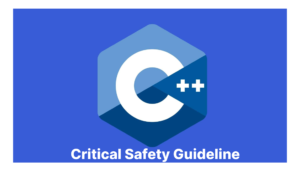
Empowering Your People Isn’t Enough | DConsulted
Learn why empowering employees alone doesn’t guarantee success. Discover how strategic alignment and leadership support drive real results.


1. Error Detection and Correction Algorithms : These identify and rectify errors during data transmission or processing.
2. Fault Tolerance Mechanisms : These identify and rectify errors during data transmission or processing.
3. Fail-safe Mechanisms: They direct the system to a safe state during unforeseen scenarios.
4. Sanity and Range Checks: These ensure that software operations remain within their intended parameters.
5. End-to-End and Timing Checks: They ensure the consistency and timeliness of data and operational sequences.
Robust testing and validation of these aspects are paramount to guarantee the safe and reliable operation of integrated systems.
As with any technology, software isn’t static. Regular updates and maintenance are crucial, bringing with them their own set of challenges. Regular software updates and maintenance, while essential, introduce potential safety challenges:
To ensure safety remains uncompromised throughout software evolution, it’s imperative to adopt a rigorous change-management process. This entails exhaustive regression testing focused on safety-critical functionalities and maintaining detailed documentation to trace and validate each change from a safety standpoint.
But beyond the software itself, it’s the interface with humans that often determines its real-world impact. The bridge between software and users can greatly impact the safety of a system. Nowhere is this more evident than in modern vehicles. Consider the following:
Given the potential risks:
Focusing on optimizing human-machine interaction, especially in dynamic environments like driving, ensures that software aligns with user expectations, reducing risks and enhancing overall safety.
Looking ahead, the tools and methodologies at our disposal are set to undergo a transformation. The rapidly evolving landscape of software safety is on the brink of another transformative shift with the potential integration of Machine Learning (ML) and Artificial Intelligence (AI). These technologies promise enhancements across requirements, architecture, and code analysis. From swiftly identifying ambiguities in documentation to simulating architectural scenarios and combing vast codebases for vulnerabilities, the future capabilities of AI and ML in software safety analysis are immense.
In a subsequent article, we’ll delve deeper into this promising intersection in an upcoming article, providing a comprehensive view of how AI and ML are set to redefine the standards of software safety analysis.
In our modern era, software has transcended mere technological advancements to bear an immense responsibility for human lives and well-being. As we’ve delved into the realm of software safety analysis, it becomes unmistakably evident that the ramifications of our decisions as software engineers stretch far beyond the confines of code or design schematics. In domains like automotive interfaces, a single software decision might be the distinction between safety and peril. In medical devices, a minor flaw could spell the difference between life and death, and in aerospace, an insignificant glitch might jeopardize entire missions.
These real-world scenarios underscore the weight of the decisions made in software development. But beyond the logical and functional demands, software engineers carry an intrinsic ethical responsibility. Our work isn’t just about ensuring seamless operation; it’s about safeguarding human lives, prioritizing well-being, and earning the unwavering trust of those who depend on our innovations daily.
In an age where technology’s grip is so pervasive, software engineers stand at the intersection of technical precision and moral obligation. As we journey ahead, navigating the evolving terrains of AI, ML, and other emerging technologies, our guiding principle remains steadfast: to ensure the safety, empowerment, and upliftment of human lives through software that’s both innovative and ethically sound.
Other Articles

Learn why empowering employees alone doesn’t guarantee success. Discover how strategic alignment and leadership support drive real results.

Generative AI tools like ChatGPT are revolutionizing software engineering by converting UML diagrams into accurate, structured code. Learn more about it here.

AI-powered requirement review tools simplify engineering verification, ensuring accuracy, efficiency, and compliance with INCOSE guidelines. Learn more about it here.

Managing and optimizing thread overhead is important for safety-critical and embedded systems. Learn more about the C++ multithread common myths here.

Managing and optimizing thread overhead is important for safety-critical and embedded systems. Learn more about the C++ multithread common myths here.

Discover the critical role of effective interface management in complex systems. Learn how centralized tools, AI-powered solutions, and well-defined processes can prevent errors, enhance collaboration, and ensure safety in industries like automotive and aerospace.

The system requirements analysis process under ASPICE and ISO26262 frameworks shapes automotive system architecture design for enhanced safety, reliability, and compliance. Learn more about it here.

Compliance with ASPICE and ISO26262 standards provides a significant impact on automotive software development. Learn more about it here.

AI technologies like ChatGPT-4 are revolutionizing requirements engineering by improving accuracy, consistency, and efficiency. Learn about the role of AI in refining, validating, and managing project requirements here.

Model-Based Systems Engineering (MBSE) offers a robust framework to streamline the entire engineering process, from design to validation. Learn more about it here.

Data-Oriented Design (DOD) can revolutionize automotive software development by enhancing performance, reducing costs, and minimizing hardware requirements. Learn more about it here.

Explore the evolution of functional safety, its growing importance in industries like automotive, and the critical role of Fault Tolerant Time Interval (FTTI) in ensuring system reliability. Learn how FTTI, along with Malfunctioning Behavior Manifestation Time (MBMT) and Hazard Manifestation Time (HMT), contributes to robust safety designs, preventing hazards in safety-related systems such as ADAS and autonomous vehicles. Discover the impact of ISO 26262 standards on the development of effective fault detection and reaction mechanisms in automotive safety.

While ISO 26262 primarily addresses functional safety, SOTIF extends the scope to focus on potential hazards arising from system behaviour, even when the system functions as intended. Learn more about it here.

Discover the risks of reinterpret_cast in safety-critical software and explore safe alternatives like polymorphism and templates for robust, efficient code.

In a rapidly evolving technological landscape, the demand for systems that can not only withstand errors but also adapt to them is paramount. This article delves into the world of Fault-Tolerant (FT) systems, emphasizing their significance in maintaining the functionality and safety of critical operations across various sectors. It explores the latest advancements in FT technology, underscoring the importance of resilience and adaptability in ensuring uninterrupted service and safeguarding against potential failures.

In a rapidly evolving technological landscape, the demand for systems that can not only withstand errors but also adapt to them is paramount. This article delves into the world of Fault-Tolerant (FT) systems, emphasizing their significance in maintaining the functionality and safety of critical operations across various sectors. It explores the latest advancements in FT technology, underscoring the importance of resilience and adaptability in ensuring uninterrupted service and safeguarding against potential failures.

Discover the transformative impact of Software-Defined Networking (SDN) and Multicast Addressing on automotive embedded systems. Explore how these technologies enhance communication efficiency, safety, and performance in the automotive industry, leading to cost-effective, scalable, and eco-friendly solutions. Dive into the technical advantages and practical applications for modern vehicles and infrastructure.

Discover how ChatGPT revolutionizes engineering with AI, accelerating learning, enhancing safety, and boosting productivity.

Defect Escape Reduction Rate and feedback loop elevate testing. Learn more about them here.

ASPICE and ISO26262 frameworks improve system development in the automotive industry, ensuring safety, compliance, and high-quality standards.

Explore the challenges of dynamic memory allocation in critical software, learn how to mitigate failures, and ensure the reliability of safety-critical systems. Real-life failures and practical solutions are discussed.

Strong types are a key concept in C++ programming for functional safety. Learn how strong types can reduce errors in critical systems with C++.

Unit testing is an essential part of the software development process. Learn more about it here.

Learn about categorizing requirements, including functional, non-functional, performance, interface etc for effective system management and development.
